The first vehicle that was truly my own was a 1986 Toyota pickup with the venerable 22RE engine. When it came into my possession, it had 200,000 miles on it, was nicely highlighted with rust and badly needed new shocks. I was in college in northern Wisconsin and living in a log cabin with a woodstove and no running water. Not much for amenities but the rent was $50 a month, a manageable sum given the $4.35 an hour minimum wage I was earning as a lifeguard at the college pool and cleaning a butcher shop in the evenings. I had an old Stihl chainsaw, a beat up Remington 870, a hippie girlfriend and not much else. I’m not sure what happened to the chainsaw, but I still have the 870 and have been married to that hippie for 25 years. I put another 100,000 miles on the Toyota before I finally sold it; putting gas, oil and not much else into it. To this day, when I see an old rusted Toyota truck coming down the road I think that maybe that’s it. Some things just pass the test of time, be they love, shotguns or engines.
I happen to be a rather skinny guy that is susceptible to getting cold. If you are also of this body form, trust me it doesn’t get any better as you get older. When I was living in that cabin in Wisconsin I bought a pair of wool pants from the local army surplus store. Too big in the waist and too short in the leg but the price was right and the climate in northern Wisconsin has been appropriately described as nine months of winter and three months of bad skiing or, as I like to call it, Canada’s Puerto Rico. The wool pants necessitated a layer underneath unless you were seeking canonization, and at that point in personal insulation history that meant the waffled cotton underwear most famously worn by Paul Bunyon. Little known fact, Paul died from exposure. The cotton underwear was soon replaced with what at the time was considered a giant leap forward, a woven nylon called polypropylene. Warm, wicking and retaining its insulating capacity even when wet, I will admit it was better than the cotton. Its major downfall that was soon apparent to me and the public in general was that it was impossible to clean. No matter what you did, it retained what I will call a locker room stench. Straight out of the wash it smelled like, for lack of a better term, ass. Living without running water meant that you really owned your clothes. I would hang my underwear on a nail next to the stove in the hope that the smell of woodsmoke would cover up the unbelievable funk of the polypro. What I ended up with was a toxic hybrid that defied description, so horrible that when you smelled it you were compelled to take another sniff just to make sure that it was as bad as you thought. The wool pants on the other hand smelled like woodsmoke and…wool. I’ve had those pants for almost thirty years now and I’ve never washed them. Let’em dry out, give them a shake and put them back on. The polypro underwear was burned, the ashes put in a lead lined container and dropped into an abandoned mine shaft because launching the remains into space was economically unfeasible.
This summer and old friend that I hadn’t seen in too many years came to visit. In our youth we had both been involved in what I will call the fly fishing industry in Montana. My friend managed a fly shop in Missoula and we were all about fishing the blue ribbon streams of the west. We were sporting the finest rods and reels, had a comprehensive selection of flies for the most discriminating of trout and were poised to pounce on the right river during the best of bug hatches. We were nerds. We had flies that literally had assholes and elbows, works of art that looked so much like the real thing that if it wasn’t tied to the end your leader you would have hit it with a flyswatter. Those super-realistic flies were effective but as time went by more often than not I would end up fishing a more impressionistic fly whose pattern probably predated the internal combustion engine. A parachute Adams, a Prince nymph or a hook wrapped with pheasant tail fibers and copper wire. These were easier to tie and worked just as well or maybe better.
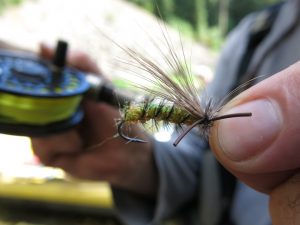 During my friends last visit, we were floating a local river full of smallmouth bass. Fishing had been good but not stellar. It was getting late in the day and we had hit a stretch of river with large slow pools. I dug into my bag and came out with a box of bugs I hadn’t seen in some time. Within were a number of monstrosities and a couple of old fashioned popping bugs that may have been hand tied by Dwight Eisenhower. I believe the trade name was Sneaky Pete, a cork bug with rubber legs and a soft hackle wrapped around the shank of the hook. I tied one on and cast it against the bank just to see what would happen. It struck the water with all the subtlety of a dropped bowling ball; birds stopped singing and took flight and mule deer a mile away raised their heads. I winced and started to strip the line back in while silently apologizing to the universe in general. About three strips in a long dark shape burst out from under a rock and inhaled the popper with a white flash of mouth. I set the hook more out of self defense than anything else and was tight into a three pound smallie that gave me all I wanted to handle on a six weight rod. We swapped oars for rod and wore ourselves out wrestling big smallmouth bass. At the end of that day the popping bug was no worse for wear and in the beam of my headlamp I cut it off of a frayed leader and stuck it back in the flybox.
During my friends last visit, we were floating a local river full of smallmouth bass. Fishing had been good but not stellar. It was getting late in the day and we had hit a stretch of river with large slow pools. I dug into my bag and came out with a box of bugs I hadn’t seen in some time. Within were a number of monstrosities and a couple of old fashioned popping bugs that may have been hand tied by Dwight Eisenhower. I believe the trade name was Sneaky Pete, a cork bug with rubber legs and a soft hackle wrapped around the shank of the hook. I tied one on and cast it against the bank just to see what would happen. It struck the water with all the subtlety of a dropped bowling ball; birds stopped singing and took flight and mule deer a mile away raised their heads. I winced and started to strip the line back in while silently apologizing to the universe in general. About three strips in a long dark shape burst out from under a rock and inhaled the popper with a white flash of mouth. I set the hook more out of self defense than anything else and was tight into a three pound smallie that gave me all I wanted to handle on a six weight rod. We swapped oars for rod and wore ourselves out wrestling big smallmouth bass. At the end of that day the popping bug was no worse for wear and in the beam of my headlamp I cut it off of a frayed leader and stuck it back in the flybox.
My progression with firearms and bows has followed a similar bell curve of complexity. I own a fair number of shotguns and have found no greater joy than when my dogs allow me to go hunting with them. Witnessing their intensity of purpose and athletic grace in the field is truly something to behold. They probably aren’t thinking the same about me, clawing my way through the brush behind them, but since they can’t reach the pedals they need someone to drive the truck. I have packed an auto-loader on occasion, usually trying to finally reap vengeance on chukars, but the auto-loaders have been sitting in the gun case for a couple years now. The old over-under I’ve had since high school comes right to my shoulder, never jams and I have learned over time that two well placed shots are usually just as effective as hastily unloading five rounds out of the automatic.
With archery it began with the old glass recurve owned by every summer camp on the planet. After that I cycled through a series of compound bows that grew more powerful and accurate over the years, finally culminating in what I will call the Death Star which would shoot a six inch group at 50 yards. With a five pin site, quiver, stabilizer, mechanical rest and harmonic dampeners the Death Star had a lot of moving parts and weighed in at over eight pounds. It needed regular maintenance, a set of allen wrenches and Popeye forearms to carry it around; let’s just say that though it was very effective I didn’t find it particularly user friendly. A few years ago I picked up a friends long bow and almost threw it over my shoulder. There was nothing to it, a stick and a string, and while its range was much less than the compound, in my considerable bow hunting history all the animals I have taken were at 25 yards or less. I felt that what I would gain would far outweigh what I had lost. I borrowed a long bow and immediately knew the Death Star would be joining the auto-loaders in long term storage.

Chuck making new friends after a long day chasing elk.

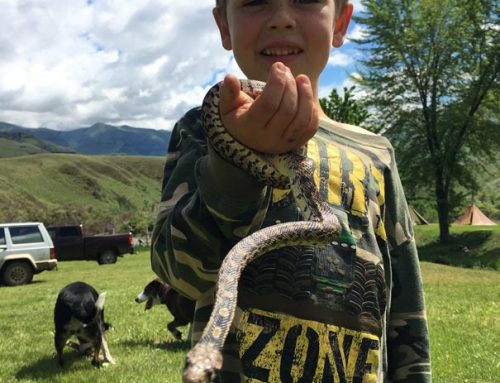
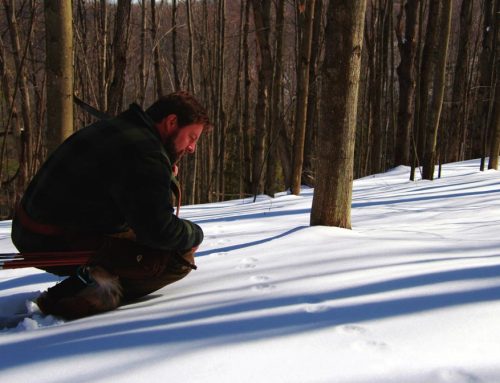
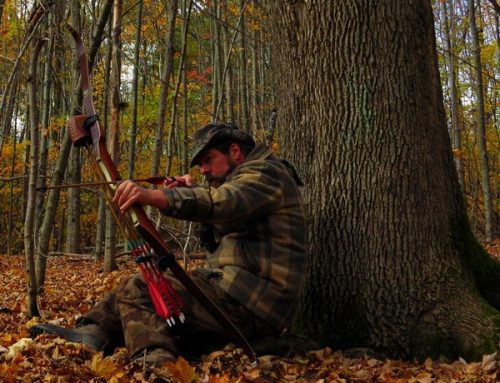
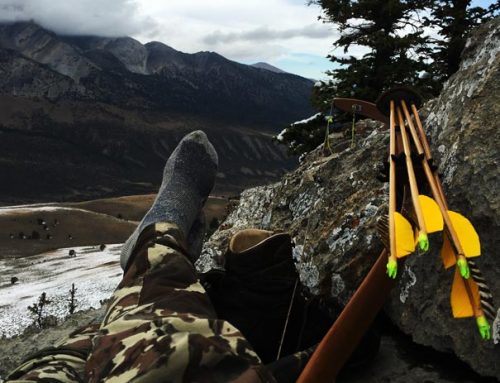
Great words Chuck….
Great article! Also, you’ve solved the mystery of why my gym shorts always smell like ass, even after being washed. Never considered that all of my plastic clothing is the problem!
Very well put. The direction my fiance and I are taking our lives at this very moment.